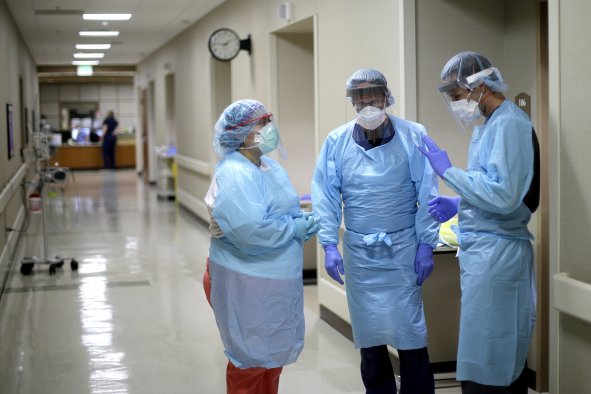If you are squeamish about your eyes, look away now. But if you’re struggling with your vision, or have cataracts, is lens replacement surgery really a safe option?
Also known as refractive lens exchange, the lens of your eye is replaced with a synthetic one called an intraocular lens. Apart from being used to remove or prevent cataracts, this procedure can correct long sightedness, short sightedness, astigmatism and even presbyopia (the gradual loss of your eyes’ ability to focus on nearby objects). Lens replacement is one of the most common operations performed in the UK, with over 300,000 procedures each year.
Jump to:
- Who is lens replacement surgery for?
- Types of surgery
- Eligibility
- How to find the right clinic
- How much does it cost?
- Benefits
- Risks
- Recovery and aftercare
Who is lens replacement surgery for?
Lens replacement surgery is the only option for those with cataracts, which are the leading cause of blindness around the world. “Our own lens changes shape as we get older and in 30 per cent of people it becomes cloudy – this is a cataract,” says Prof Dan Reinstein, laser eye surgeon at the London Vision Clinic.
But while there are patients for whom it is the only option, in far too many cases this procedure, which is more invasive and riskier than laser surgery, is being carried out needlessly. Prof William Ayliffe, a consultant ophthalmologist based at the Lister Hospital in Chelsea and a specialist in lens replacement surgery, says: “I only advocate lens replacement surgery for patients for whom there are no other options, or when it’s advisable because of early cataracts or certain anatomical factors”.
Back to index
Types of lens replacement surgery
“A Phakik lens implant is like an intraocular contact lens, and it’s used in patients where there are extreme degrees of shortsightedness, where laser surgery is not suitable,” says Prof Ayliffe. Visual outcomes for Phakik lens implants have been found to be better than for refractive lens exchange.
Back to index
Who is eligible?
While not suitable for anyone under 40, there is no upper age limit for lens replacement surgery. If you are contemplating lens replacement surgery you need to be in good general health, have no eye infections or allergies to anaesthetic. If you have another eye condition such as macular degeneration, you may not be suitable.
What happens in the evaluation process?
During your initial consultation at a clinic or eye hospital your specialist eye surgeon will scan and test your eyes to determine your suitability for lens replacement surgery.
If you’re being evaluated for cataracts, your eye doctor will examine your lens for signs of a cataract and will also conduct a fluid pressure test – a quick and painless test using a tonometer to measure the pressure of the fluid in the eye.
How do you decide if it’s suitable for you?
“Lens exchange can be suitable for someone with a shallow chamber of the eye and a risk of glaucoma, which is a small percentage of the population,” says Prof Ayliffe. “It would also be suitable for someone with extreme shortsightedness or longsightedness, where the cornea is too thin or where there are early cataracts”.
Alex Ionides is a consultant ophthalmologist and lead clinician at Moorfields Private Eye Hospital. He says: “The best candidates for lens replacement surgery with implantation of a multifocal lens to give good distance vision (with the risk of halos at night) and reasonable near vision (still occasionally needing cheap reading glasses) are those who have the most to gain from it.
“If you are fine for distance, and only need reading glasses, you are not, generally speaking, a good candidate and can often end up very unhappy with your vision. Those who have the most to gain need glasses for distance and even stronger glasses for near, as the procedure gets them out of glasses for distance and they can do most near activities without needing reading glasses all the time. People who undergo the lens surgery are usually in their late 50s, 60s and 70s.”
Back to index
How to find the right clinic
Find a clinic that offers a comprehensive range of treatments.
“In this way, patients can be assured that the advice they receive is based solely on what is best for their eyes, rather than the limitations of the clinic’s capabilities,” says Prof Reinstein. “Ideally go to a consultant eye surgeon that specialises in cataract and refractive surgery who has a consultant job in a recognised NHS hospital.”
For patients who have been told that laser surgery is not a good option because of their prescription needs being too extreme, lens replacement surgery could be the best treatment.
“This consultant will usually work in a private clinic and be able to fully assess and give clear, logical and straightforward advice,” says Ionides. “Yet for many people it’s not necessary for them to have lens replacement when they could have Presbyond (a laser procedure that can eradicate the need for reading glasses, which can also correct long-sightedness and astigmatism).
Back to index
How much does it cost?
You can expect to pay between £1,995 and £3,995 per eye for lens surgery using monofocal lenses and between £3,195 and £4,500 per eye for multifocal or trifocal lenses, according to the Laser Eye Surgery Hub.
Costs for lens replacement surgery vary, depending on the clinic and the lens technique they use, and the type of lens used.
Back to index
The benefits
The benefits of lens replacement surgery are knowing you won’t develop cataracts in old age, the fact that it can treat strong prescriptions, and can be a permanent solution to a range of vision problems. It can also improve your vision if you have cataracts, and your vision will remain stable indefinitely after surgery, unless you develop glaucoma or macular degeneration.
According to the Laser Surgery Eye Hub, more than 95 per cent of surgeries are successful, with fewer than 5 per cent of cases experiencing complications such as inflammation, bleeding, infection and retinal detachment.
Back to index
The risks
“There are surgical risks – immediate ones during the surgery as well as intermediate ones, like problems with the lens capsule becoming opaque, or a complication called anterior capsule fibrosis and phimosis. And these can potentially result in blindness, although that’s very rare,” says Prof Ayliffe.
“Complication rates for lens replacement surgery are higher than people recognise.”
But that’s not all. “The big worry is infection in the eye, endophthalmitis, which affects around one in every two to three thousand, and it’s usually devastating to the eye,” says Prof Ayliffe.
Endophthalmitis is a serious complication of cataract surgery involving microorganisms entering the eye. “If you have normal vision when you wear glasses, it’s not worth the risk of lens replacement.”
A potential problem with lens replacement of multifocal lenses is contrast issues, such as the ability to see low contrast images in the real world, such as a street sign on a dark roadway. Compounded with macular degeneration and problems occurring with the cornea, such as swelling which can cause a decrease in vision, this can lead to dissatisfaction with the results of surgery.
And there are other risks such as dysphotopsias, which are visual phenomena that can occur after cataract surgery, caused by an external light source superimposing unwanted patterns over the true retinal image. They include glare, light streaks, haloes, lines and shadows, and in some cases surgical intervention is needed to correct your vision. “Of those who have lens replacement of multifocal lenses, 5 per cent of them end up with problems with night vision, but can’t have their natural lens put back in,” says Prof Reinstein.
Back to index
Recovery and aftercare
Recovery takes around two weeks, although it can take a few months to adjust to your vision improvements. You may see haloes and strobes of light for a few weeks as you heal, but these should disappear after about 10 to 12 weeks. Post-operative care will vary depending on the clinic
Recovery Timeline
Straight after lens surgery: Once the anaesthetic wears off you may experience temporary discomfort, so use over-the-counter pain relief as well as medication and anti-inflammatory and antibiotic eye drops your surgeon will have given you to aid the healing process.
Usually the next day: Shortly after surgery, usually the next day, your surgeon will examine and assess your eyes to check they are starting to heal.
One week: A final appointment to check your vision and healing.
12 months of aftercare: Most clinics offer a year of aftercare as standard.
Post-operative care instructions
- Overnight wear the eye shield you will be given to prevent rubbing your eyes.
- Avoid getting water in your eyes, choosing a bath over a shower during the first week post-surgery. If showers are the only option, wear your protective shield.
- Do not drive or fly until you get the all-clear from your doctor.
- Avoid strenuous activity for two weeks and do not go swimming for four to six weeks
- Avoid dusty and smoky environments.
- Wear sunglasses on bright days for at least a year after surgery.
- Eye drops can greatly help your recovery process, used under the advice of the consultant.
- “And avoid jumping up and down for a while,” says Prof Ayliffe.
Back to index
Disclaimer: The copyright of this article belongs to the original author. Reposting this article is solely for the purpose of information dissemination and does not constitute any investment advice. If there is any infringement, please contact us immediately. We will make corrections or deletions as necessary. Thank you.




